Don’t Grow Olive Trees In Pots Without Following These 9 Tips From Experts

Reviewed By DAN ORI

Dan has over 27 years’ under his belt caring for plants and gardens. Working as a Horticultural Instructor and Consultant, he draws on a diverse range of experience that includes working as a Head Gardener, Tree Surgeon, Garden Centre Trouble Shooter, and writer of academic papers. Dan has a Level 3 Diploma in Horticulture and is currently a candidate for the RHS’s most prestigious award – The Master of Horticulture.
Contributions From PAUL & ANTONIA SMITH

With 30 years’ experience as an Arborist, Paul has a particular soft spot for olive trees, which he has been growing in the UK for over 10 years. The duo import their trees from licenced suppliers in Spain and select them by hand for their shape and form.
IN THIS GUIDE
- 1) UK-Grown Olive Trees Are Best In Pots
- 2) Base Your Container Size On Maturity
- 3) Natural Stone Or Terracotta Work Best
- 4) Avoid Manure And Water-Retentive Compost
- 5) Always Position Potted Olives In Full Sun
- 6) Choose Compact Varieties With A Vertical Form
- 7) Pot Them On Every Few Years
- 8) Only Ever Plant One Per Pot
- 9) Water, Feed & Prune Regularly
An olive tree will bring an unmistakable touch of the Mediterranean to your British garden with its textured bark, silvery-green foliage and well-branched habit.
Olea europaea is rightfully recognised as being among the toughest trees and can withstand harsh weather conditions in the UK.
However, in order to produce fruit, these trees need care and nurturing in any location and this is all the more necessary when they are grown in climatic zones that are very different from those of their native regions.
So, if you are thinking about growing an olive tree for the fruit, keep in mind that it may rarely crop in northern parts of the UK.
However – there is no harm in trying – and with a combination of diligence and luck, someday you just might see olives on your container-grown tree!
| Difficulty | Medium |
| Equipment Required | Large pot, suitable loam-based potting mix, seaweed-based fertiliser, small olive tree |
1) UK-Grown Olive Trees Are Best In Pots
Not only can you grow olives in pots, but it is also the only way they should be grown in heavy soils and northern regions of the UK.
Olive trees are slow-growing and relatively small, and, with relatively few demands on the soil, are among the most suitable trees for growing in containers.
Though olive trees are sufficiently hardy for most regions of the UK, frost, sleet and snow are very harmful to these evergreen shrubs.

These would zap any chances of them bearing fruit and a prolonged hard freeze could very well kill the tree.
Olive trees also need to sit in full sun all year round.
In many gardens, the area that is soaked in sun in June will be rather different from the area that gets maximum sun in December.
For these reasons, a container-grown olive tree is the best option for growing these lovely plants in the UK.
2) Base Your Container Size On Maturity
Unless you take the unlikely route of propagating an olive tree from cuttings, you will most likely buy a small tree in a pot.
Small young trees are sold in 15L pots, whilst more mature trees are sold in 50L containers.
You will, of course, need to pot on your olive tree, at which time you will have to choose a container.
The new container should have multiple drainage holes.

3) Natural Stone Or Terracotta Work Best
For this statement tree, I’d suggest a decorative container made of natural stone or a special frost-proof terracotta container.
Avoid using synthetic-material for your olive tree container.
As for the shape, rather than a container of regular dimensions, choose one that is about as wide as it is deep.
Be aware that an olive tree will eventually have to be housed in a very large container, around 200L or more.
4) Avoid Manure And Water-Retentive Compost
Do not use manure or water-retentive compost for these shrubs, as they do not like constantly moist soil.
Instead, fertilise them judiciously.
A soil pH between 6.0-7.0 is ideal, but any that is moderately acidic to neutral will be perfectly fine.
5) Always Position Potted Olives In Full Sun
No matter what the weather or the season, position the container in full sun.
The container should be positioned in a sheltered spot with a southerly aspect.
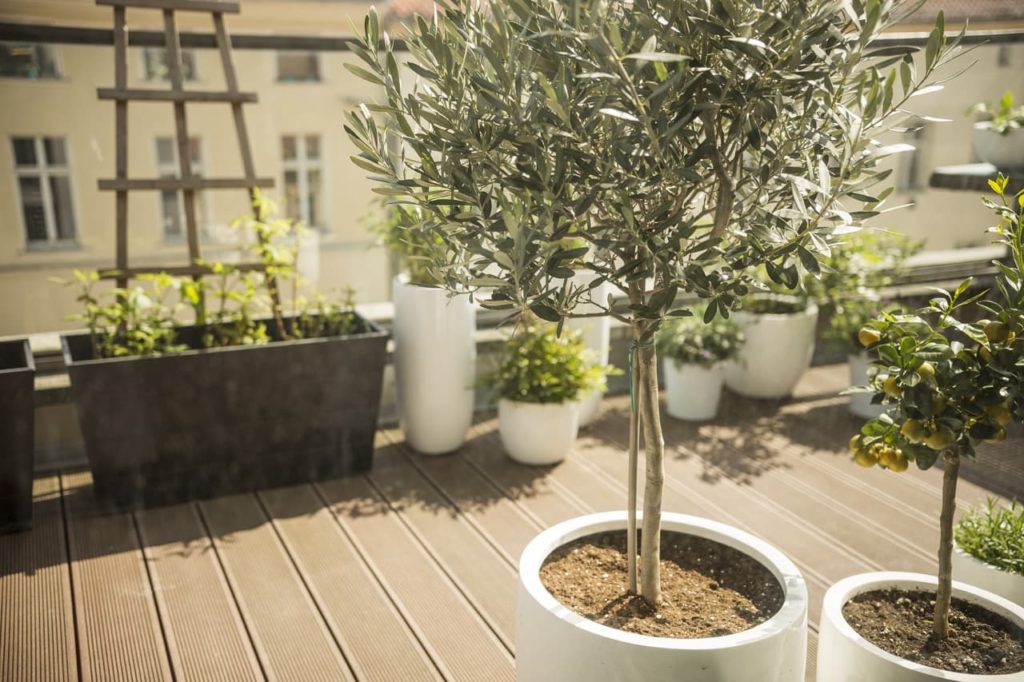
Though this is not strictly necessary during summer, it is imperative during winter and cold weather, especially in the chillier regions of the country.
Olive trees should not be exposed to frost, sleet or snow.
Should there be an extended hard freeze, wrap the pot with burlap or an old blanket and protect new shoots with horti-fleece.
6) Choose Compact Varieties With A Vertical Form
Growing an olive tree in the UK is more of a challenge than growing most other trees, whether they are containerised or in the open ground.
If you are successful then you may become the happy owner of a very special heirloom tree that will be passed down from generation to generation.
To get off to the best possible start, you will need to choose your variety well.
Though you can certainly go with the widely-available species tree, there are four varieties that I feel are especially well-suited for container growing in the UK.
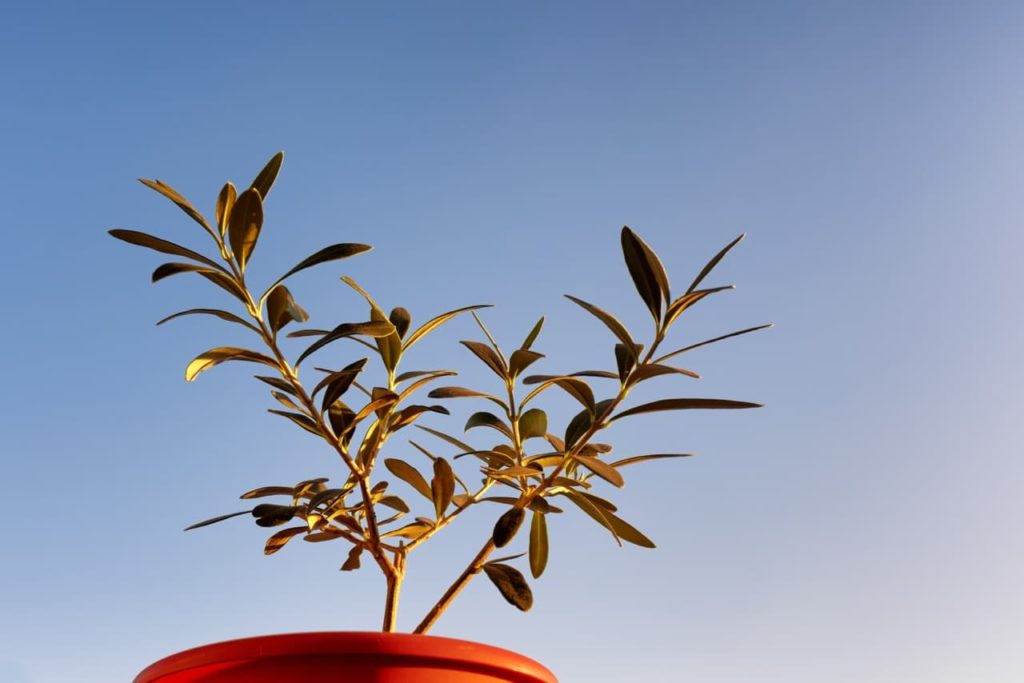
These varieties are:
O. europaea ‘Arbequina’
Can be kept quite compact, is self-fertile and reliably so.
This variety has a very ornamental tree-like form.
O. europaea ‘Chemlali’
This variety is considered self-fertile, is relatively hardy and has a vertical habit.
It is also a compact choice.
O. europaea ‘Fastigiata’
Another compact option, this cultivar is especially cold-hardy and also has a vertical-branching form.
In addition to this, it has flowers that are scented.
O. europaea ‘Frantoio’
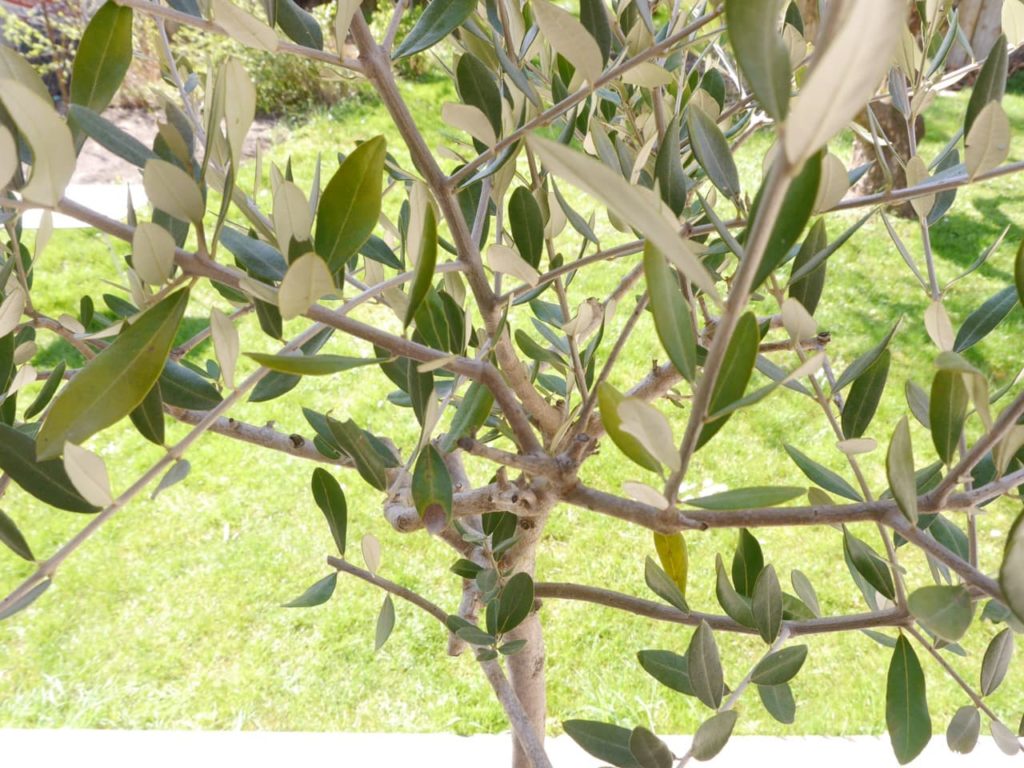
‘Frantoio’ is especially well-suited for container growing.
This variety is small, self-fertile and has a tree-like habit.
7) Pot Them On Every Few Years
You will need to pot up these evergreens, but they are slow growing and need to be housed in a pot that is big enough to begin with.
Therefore, choose a pot that is two sizes up.
A young tree will need to be potted on every 1-2 years, whilst slightly older trees only need repotting every 2-3.
Mature trees that are aged between 6-10 should be potted on every 4 years.
Even older trees will need to be potted up too, but infrequently.
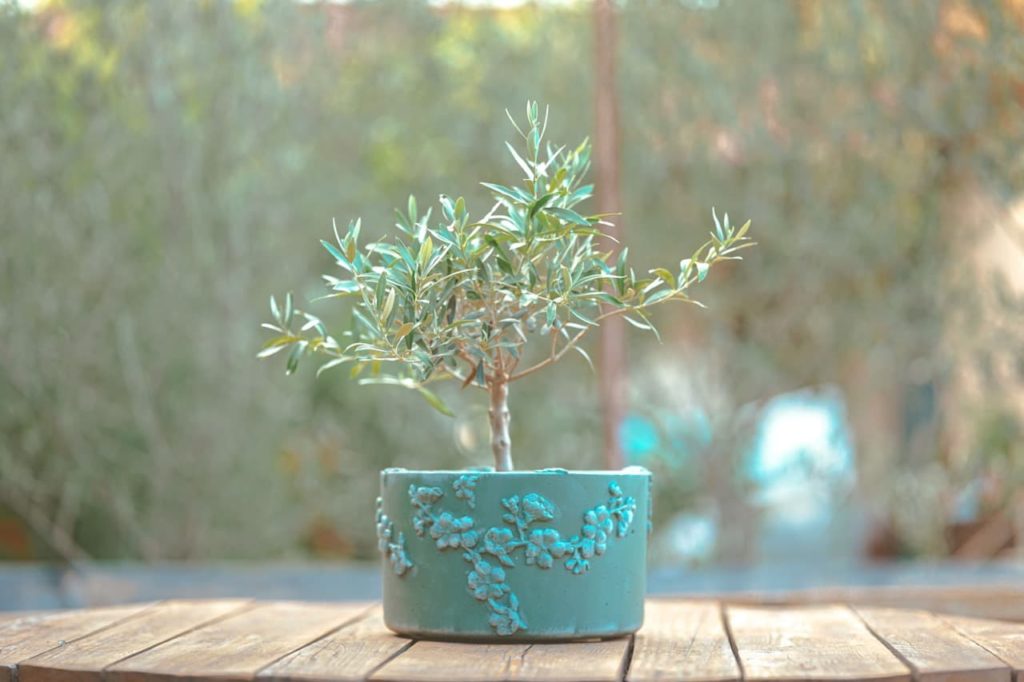
Every spring, check whether the roots are emerging from the drainage holes of the pot.
“A good prune to ensure it doesn’t outgrow its pot is essential,” Antonia Smith from The Norfolk Olive Tree Company shares.
“An olive tree will happily stay in the same pot if you keep it pruned back in April and October and then top dress it with good quality compost.”
8) Only Ever Plant One Per Pot
You can, of course, try to propagate multiple cuttings in one pot if you wish, but even a small, young plant should be in its own pot.
9) Water, Feed & Prune Regularly
Olive trees should be watered regularly, more so in summer and during hot weather than in winter.
Even though olive trees need to be periodically potted up, a container-bound olive from the age of about 5 years onwards should be judiciously pruned every year or two.
To feed, apply a slow-release fertiliser once in mid-spring and once in mid-summer, or apply a nitrogen-oriented fertiliser every 3 weeks from mid-spring to early autumn.
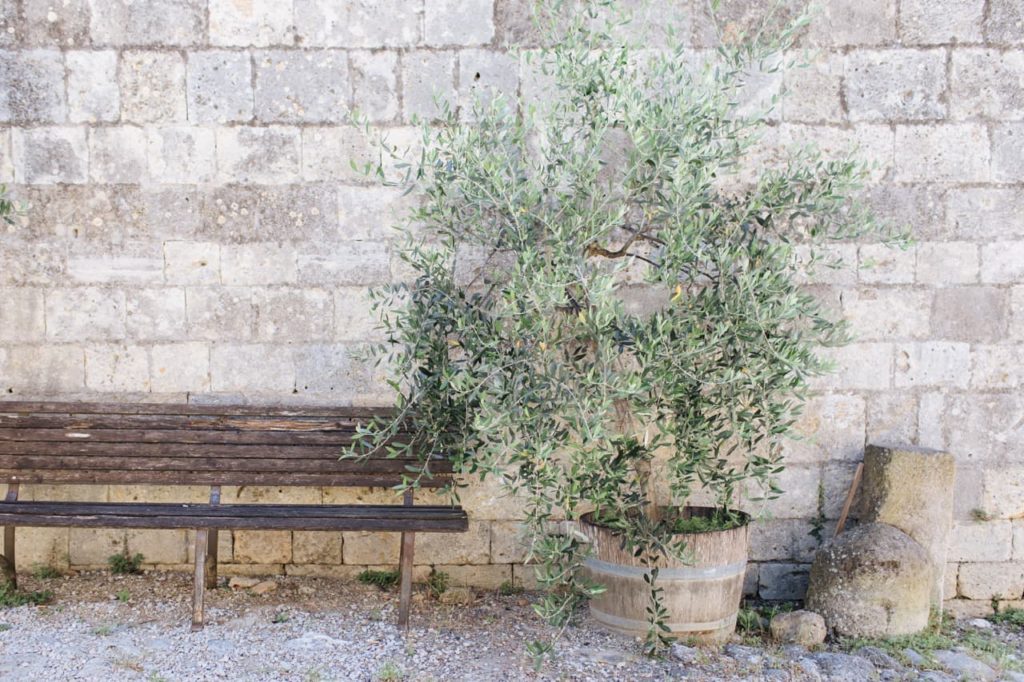
“A potted olive tree will thrive providing you feed it regularly from late March to October,” says Antonia.
“Seaweed-based feeds, such as tomato fertiliser, are ideal.”
I recommend that you dilute the fertiliser to 60-70% of the instructed strength, apply it well away from the crown and water the plant both before and after the application.
If you tend to your container-grown olive tree by following these tips, you may well end up with an heirloom tree that you can pass on to future generations!

